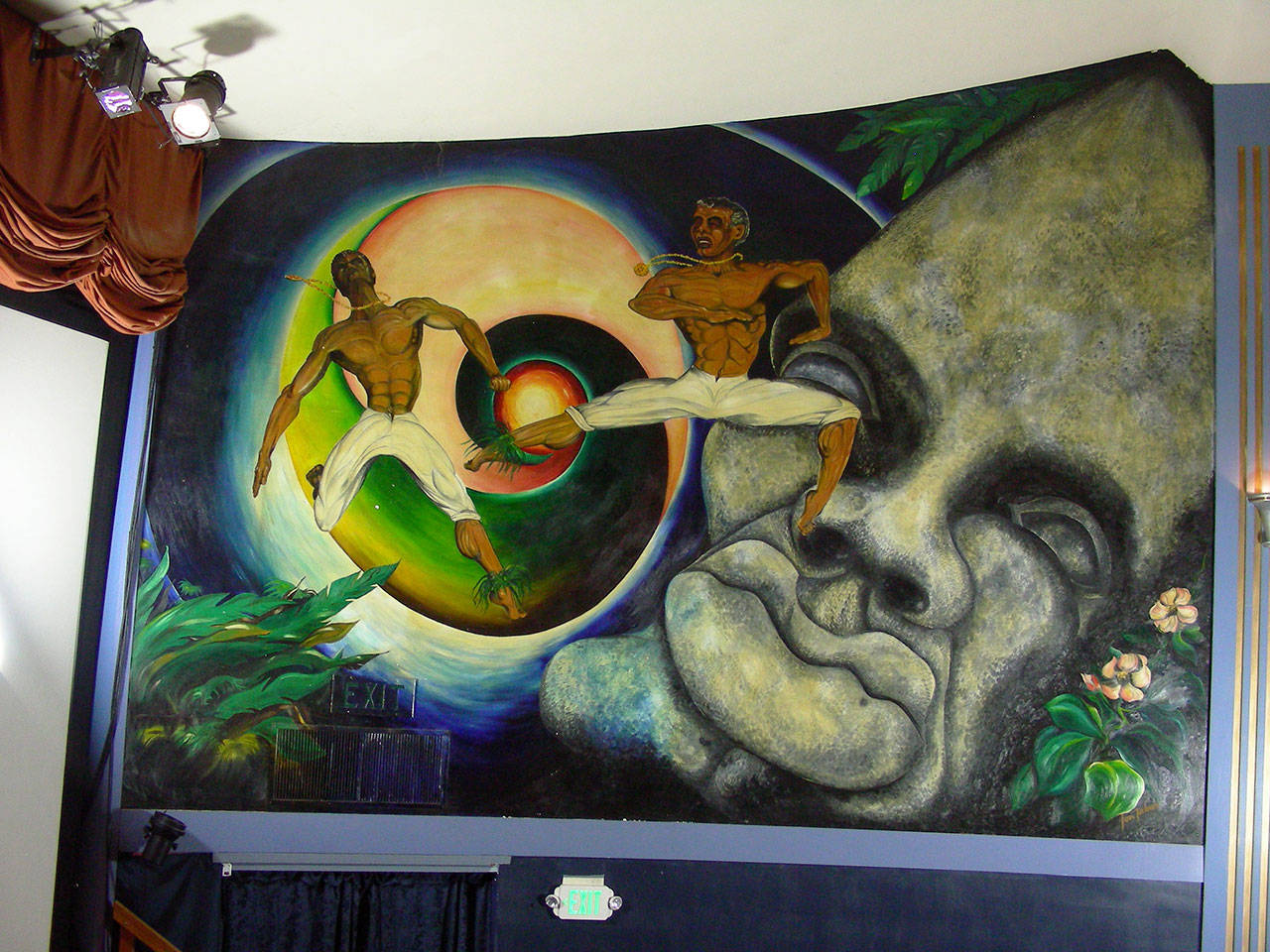Amid national conversation about donning blackface and confronting racism in the Trump era, several islanders have commented that a historic mural in the Vashon Theatre may be promoting an offensive stereotype.
Painted by longtime islander and artist Jac Tabor in 1952, the mural — flanking the theater’s screen — depicts scenes inspired by a 1920s book series contending that an aboriginal civilization once flourished on Mu, a fictional lost continent that sank into the Pacific Ocean after a cataclysmic disaster.
In the mural, men and women of color dance against psychedelic backdrops illuminating the dark night sky. A snake ready to strike coils around the trunk of a tree as the sun sets behind, and one of the towering Moai statues — as famously seen on Easter Island in Polynesia — keeps watch.
The statue’s thick, protruding lips painted by Tabor were the subject of a recent letter to the editor in The Beachcomber (“Local mural needs to addressed,” Feb. 13). Islander Swaneagle Fitzgerald asserted that such a portrayal is a common stereotype and mockery of African Americans and called for the mural’s removal. In response to Fitzgerald’s letter, islander Sam Van Fleet called the mural “groan-worthy” but suggested that the issue was more nuanced (“Murals: Different perspective proves useful,” Feb. 20).
Eileen Wolcott, the owner of the Vashon Theatre, said she doesn’t know what is offensive about it.
“When I first arrived on the scene, some people hated those murals, and some people liked those murals,” said Wolcott, who purchased the business in 2003. She said no one has ever expressed to her that they believe the images in the mural to be racist until recently.
Wolcott said it is not her intention for anyone to feel unwelcome in the theatre, and that her personal opinion is irrelevant in the wider discussion. But she believes Tabor’s mural has artistic merit and is worthy of preservation.
“I feel like I’m the protector of something I have been given,” she said.
Islander and documentary filmmaker Peter Ray said he has been fascinated by the mural since he first moved to Vashon in 1982.
“Normally you go into theaters and it might be ornate or mostly just a blank wall,” he said. “Just to come and find these crazy paintings, I was curious.”
Ray began researching the origin of the mural for an article in The Ticket, now The Vashon Loop. He said he learned that Tabor, a 1948 graduate of Vashon High School, discovered author James Churchward’s book “Lost Continent of Mu, the Motherland of Man,” while attending a science fiction convention. According to Ray, Tabor’s curiosity about the book shaped his early creative life — he spent long nights on top of scaffolding in the theater painting the mural’s figures and iconography, later naming a sailboat the Mu, which he docked in Quartermaster Harbor.
But Ray said not everyone is an admirer of Tabor’s work, noting that throughout the years, people have said they find the mural weird or even frightening. On the question of whether the mural is racist, he said it has given him pause.
“There are two dancing men that are bare-chested. The physics are kind of exaggerated. The musculature is a little weird. They’re in sort of Capri pants that are sort of Caribbean,” he said.
Still, Ray is adamant that it is not offensive, and called any effort to censor or sterilize the mural as misdirected.
“It’s one of the questions that revolve around any artwork, I think,” he said. “If you alter it or deface it, you’re changing the artists’ original intentions. If you remove it, it’s a cultural bit of the island that would never be replaced.”
Islander Trish Dziko was a keynote speaker at a panel honoring Dr. Martin Luther King Jr. at Vashon Center for the Arts in January. She said there is deeper prejudice on Vashon than typified by the mural, which she has never seen, and believes islanders would have a greater impact by reckoning with their own privileges or finding more important causes to support. But she said the mural might be a good place to start for some.
“I think people need to decide if this is what they want to go to bat for. I think folks need to have a strategy of how they want to combat [racism]. If this fits it, great,” she said.
Dziko said part of the problem facing Vashon is whether islanders are willing to be accountable for their own complacency in the marginalization of underrepresented people.
“The people who live here have to decide what they care about, and who they care about,” she said.



